According to HubSpot’s research, 65% of businesses said that generating traffic and leads was their biggest marketing challenge.
That challenge was even greater than proving ROI, securing budget, and hiring top talent.
So clearly lead-gen is a big deal.
If you want to learn how to generate leads online for your business… you’re certainly not alone.
Lots of businesses are struggling.
That’s why, in this guide, we’re going to explain what lead gen is and why it’s important. Then we’ll show you a proven 4-step strategy for generating leads online.
Off we go!
What is Lead Generation?
Lead generation is the process that marketers use to attract and identify a businesses’ target market. This process usually includes collecting the lead’s contact information (name, email, phone number, etc) so that marketers or salespeople can follow up. Lead generation is most successful when the marketers vet or qualify leads to ensure that the people they’re identifying as leads are actually part of the business’s target market.

Put simply, a lead is someone who’s expressed interest in your products, services, or business as a whole. Essentially, you assume they are a part of your target market because of their past behaviors.
But it gets a little more complicated than that.
When you’re doing research on lead generation, there are a few terms that you’ll want to understand.
- Marketing Qualified Lead (MQL) — This is a lead that’s showed interest in your online marketing materials (subscribed to your email list, interacted with a Facebook ad, etc), but likely isn’t ready to receive a sales call.
- Sales Qualified Lead (SQL) — This is a person who’s shown a clear interest in your service (maybe they went all the way through your sales funnel and then emailed a question rather than finishing their purchase) and is a top priority for receiving a call from you or your sales team.
- Product Qualified Lead (PQL) — This is a person who’s started using your product and is now expressing interest in becoming a paid customer. PQLs primarily exist for companies that have free trials or ongoing freemium plans (like we do here at ClickFunnels); while the person is using the free service, they show interest in upgrading to the paid version and become a PQL.
- Service Qualified Lead (SQL) — This is a person who expresses interest in becoming a paying customer to your customer service team. It’s then the job of that customer service representative to pass the lead onto sales.
Why is Lead Generation Important?
Lead generation is important for growing your business because it allows you to identify and separate your target market from everyone else who’s seeing your ads or visiting your website.
Once you’ve done that, you can create an email list, a marketing strategy, and a follow-up process for selling to those leads.
In Russell Brunson’s words (from his bestselling book, Traffic Secrets), these leads become traffic that you own — that is, since you have the contact information for these leads, you can direct that traffic however, wherever, and whenever you want.
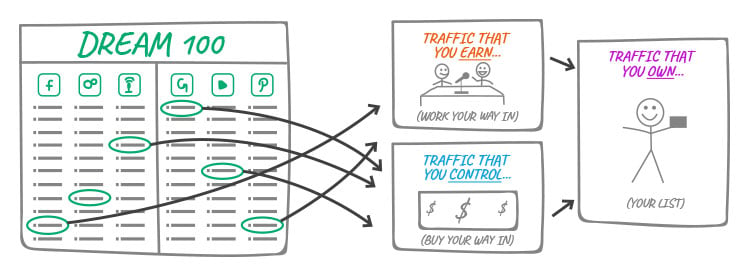
That’s what makes a lead so valuable.
Russell Brunson contrasts this with traffic that you earn (think of public relations and networking) and traffic that you control (think of paid ads and sponsorships).
The primary goal of those two channels is to drive people in your target market toward giving you their email address or phone number so that they become traffic that you own.
And the more leads you generate, the bigger the potential growth of your business.
Here are some statistics that indicate the importance of lead generation for growing your business…
- 80% of B2B companies focus on lead-gen as a content marketing goal (Source)
- 79% of B2B marketers think that email is the most effective channel for demand generation (Source)
- Businesses that nurture leads generate 50% more sales for 33% less cost (Source)
- Leads that are nurtured spend 47% more than non-nurtured leads (Source)
- 63% of leads who inquire about your business will take 3 months to convert (Source)
But (as you’ve probably already discovered) lead generation is hard.
And next, we’re going to talk about why and how most B2B companies are doing it wrong.
The Problem With Most B2B Lead-Gen Strategies
Every month, 17,000 people search “lead generation” on Google.

Globally, that number jumps to 68,000 per month.
That’s a LOT of searches.
More importantly, that’s a lot of people who are trying to figure out how to generate leads and grow their businesses.
But there’s a problem.
Many business owners and marketers fall into the same trap — they run advertisements and pay for sponsorships and drive traffic to their website… all to generate a painfully small number of leads.
But why do so many business owners get such bad results?
Well, the main reason is that a website just doesn’t cut it anymore… especially when we’re talking about trying to convert traffic that you’re paying for.

Because here’s the kicker — you can’t control your website traffic.
In many ways, a website is like a digital brochure. People can browse, they can learn about your business, they can buy any of your products, they can read your blog, or they can listen to your podcast.
And because they can’t do everything… they don’t do anything.
(This is called analysis paralysis)
That’s why, at ClickFunnels, we believe the website is dead…
… and the sales funnel has taken its place as a much higher-converting marketing asset.
(That’s not to say that you shouldn’t have a website… but you definitely shouldn’t drive paid traffic to it)
A sales funnel is a series of pages that are crafted to drive visitors, one step at a time, toward taking the exact action that you want them to take.

Where a website is like giving someone a digital brochure, a sales funnel is like having your best salesperson walk alongside the prospect. It has only a single goal (to generate leads, for instance) and it addresses the prospect’s objections at the right moment.
Because of that, sales funnels are far more effective at converting high-quality leads than websites are.
And you don’t have to take our word for it… check out how sales funnels changed James’ B2B business!
With a high-converting sales funnel, here’s what the lead-gen process looks like now. You spend $500 in paid ads to generate 20-30 leads. And you can close on half of those leads once you get them on the phone — that’s 10-15 new clients with just $500!
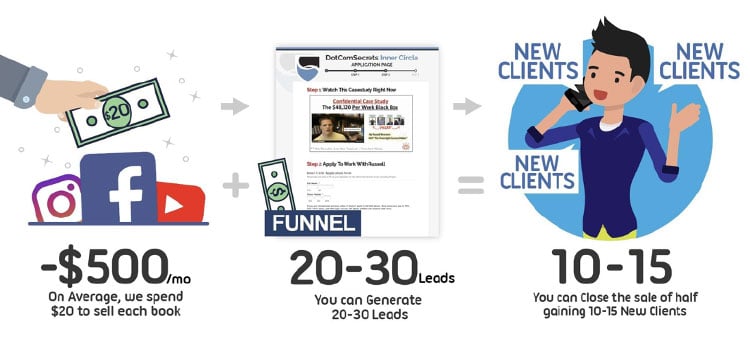
This is way more effective than cold calling. It’s way more effective than cold emailing. And it’s way more effective than sending traffic to your website.
Sound good?
Well, that’s the high-level view.
But how do you actually do this?
Follow these 6 steps!
Start by Claiming Your FREE ClickFunnels Account!
6 Steps To Generate High-Quality Leads Online
Fortunately, generating high-quality leads online is almost entirely a science. Here we’re going to give you everything you need to build an effective B2B lead-gen strategy for your business.
Where we don’t go into detail about a specific process or topic, we’ll link to other content that’ll guide you.
Let’s dive in!
1. Identifying Your Target Market
If you haven’t already, the first step is to identify your target market.
These are the people who you want to serve… they are the ones who will be most naturally interested in your products or services because you’ve created your products or services for them.
So…
Who are they? What do they want? What their greatest fears and desires? How old are they? Where do they live? How much money do they make?
These are the sort of questions that you should have clear answers to.
It can be helpful to imagine your target market as a single person rather than as a group of people — you might even name this fictional avatar and find a photo to represent them.
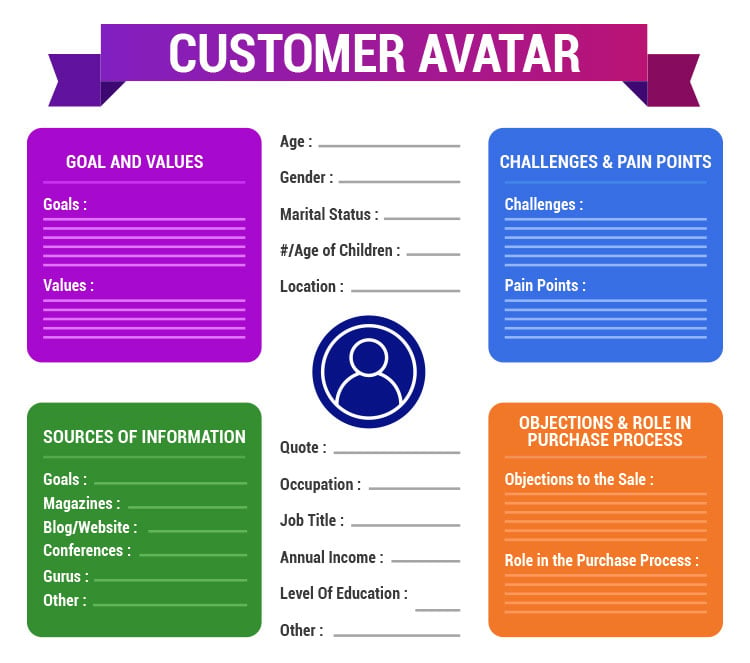
The better that you understand your target market, the easier it’ll be to find them… and then sell to them.
Eventually, you should understand your target market better than they understand themselves.
Remember: generating leads isn’t just about getting random people added to your email list… it’s about getting contact information for the right people (i.e. your dream customers).
Here’s a starting place for questions to ask yourself about your target market.
- What is your target market demographic?
- Where do they live?
- What industry do they work in?
- How much money do they make?
- What hobbies do they have?
- How do they communicate? What words and phrases are they familiar with?
- What is their worldview?
- Who is important to them?
- What are their biggest challenges?
- What are their biggest objections to buying from you?
Spend a little time brainstorming answers to these questions. Then condense the final answers into a single, easy-to-read document or poster so that everyone in your business is on the same page.
Here’s a great video of John Lee Dumas, the host of Entrepreneur On Fire, describing his dream customer (whom he named Jimmy) — notice how specific he is about exactly who he wants to serve.
Name your customer avatar, find a picture that fits your mental image, and become obsessed with that person — that is your dream customer.
Now we’re going to try and find them.
For more information, I highly recommend checking out Expert Secrets — in that book, Russell Brunson goes into awesome detail about identifying your target market.
2. Finding Your Dream Customers
Now that you know who your dream customers are, it’s time to find them.
The good news about this part of the process is that the internet has made it easier than ever to track down your target market.
There are influencers, Facebook groups, YouTube channels, Subreddits, forums, and online publications that cater specifically to your target market.
Find those places… and you’ll find a treasure trove of dream customers.
How do you do that?
To start, check out this video from Russell Brunson…
The goal here is pretty simple.
You want to find the places where your dream customers hang out. We recommend listing at least 5 of each of the following categories…
- 5 influencers that your dream customers pays attention to.
- 5 YouTube channels that your dream customers watch.
- 5 Facebook groups that your dream customers engage with.
- 5 forums that your dream customers spend time on.
- 5 blogs that your dream customers read.
- 5 podcasts that your dream customers listen to.
Start with 5 each, but don’t hesitate to add more. The more places that you identify now, the more opportunities you’ll have to drive traffic in Step 6.
Eventually, it’s a good idea to aim for having 100 different online communities on your list. We call this the Dream 100 — these are the 100 places where you’d love to spread your message.

But getting 100 takes time. So do what you can and move on.
Put this list aside for now and, in the final step, we’ll talk about how you can leverage these online communities to get your products and services in front of your target market and generate high-quality leads like clockwork.
3. Designing Your Lead Magnet
You’re probably starting to figure out what the overall strategy is here for generating leads.
First, you figure out where your dream customers are hanging out online. Then, you work your way in or buy your way into those different channels (more on that in Step 6).
After you’ve done so, you’ll be able to share your products, services, and brand message with your dream customers.
But remember that you’ll want to use a sales funnel to do this — not a website — so that you can generate as many leads as possible and turn all of those dream customers into traffic that you own.
How are you going to do that?
The first step is to create a lead magnet — this is something (like a product, presentation, or service) that you offer for free or at a massive discount in exchange for the person’s contact information.
Here’s an example of someone offering an eBook…
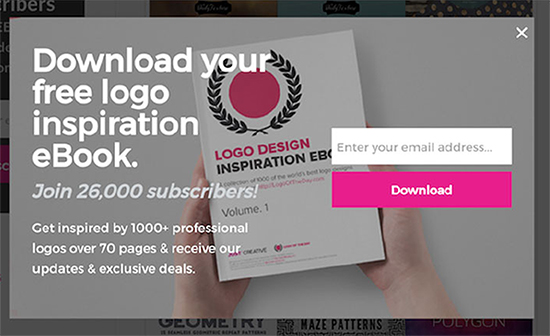
Here’s another example of someone who’s offering a free consultation…

… a free trial…
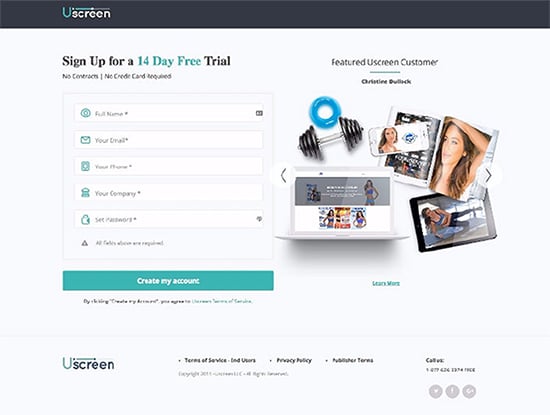
… and a webinar…

As you can see, there are a lot of different types of lead magnets that you can create.
Here’s what you have to understand: people aren’t going to give you their contact information unless you give them something super valuable in return.
The key to designing an effective lead magnet is to create something that your dream customers desperately want… and then give it to them for free.
We do this all the time at ClickFunnels and it pays us back 10-fold.
Answer this question: what is your target market’s most immediate problem and what free resource could you create to help them solve it?
Then create the resource and give it a sexy title.
In the next step, we’re going to craft your lead-gen sales funnel and your lead magnet is going to be a big part of it.
If you need more time to create your lead magnet, then pause here, bookmark the page, and come back once you have it.
But also, don’t overthink it. Effective lead magnets are often simple lead magnets. They solve a problem and they do so quickly.
You might even try to challenge yourself by asking, what’s a resource my dream customers would love that could create in 30 minutes?
For B2B companies, eBooks, free consultations, free trials, downloadable guides, and webinars tend to work really well.
For more information, check out this in-depth guide on creating a high-effective lead magnet. It’ll take you through the process one step at a time and show you tons of examples.
4. Crafting The Sales Funnel
The sales funnel is where the rubber meets the road.
You’ve found your dream customers, created a lead magnet, and driven many of them to the first page of your sales funnel…
What happens next?
The answer to that question depends on how effective your lead magnet and sales funnel are at converting visitors into leads.
To convert visitors into leads effectively as a B2B company, here are 5 sales funnels that you can choose from depending on the lead magnet you want to use.
(Get your free ClickFunnels account to get immediate access to all of these sales funnels!)
Webinar/Autowebinar Funnel
This sales funnel is ideal if you’re comfortable doing an online presentation and sharing your expertise. We use Webinar Funnels all the time at ClickFunnels because they’re crazy effective. In this case, the presentation is your lead magnet and the process by which you generate leads. Then there’s a pitch or follow-up process at the end to try and turn those shiny new leads into paying customers.
Summit Funnel
One great way to build your following and to generate leads is by hosting an online summit. You can get expert speakers (maybe you’re one of them!), collect registrants as leads, host the event, and then follow up with leads afterwards.
Lead Magnet Funnel
The lead magnet funnel is perfect if you’re wanting to offer a downloadable resource — like an eBook, checklist, free course, or essay — in return for people’s contact information.
Live Demo Funnel
The Live Demo Funnels is perfect if you’re selling a service or software. It’ll help you get people signed up for a live demo so that you can generate leads and show people your service all at the same time.
Application Funnel
If you’re a coach, consultant, or agency, then an application funnel is sometimes the best way to go. It helps to qualify leads so that you’re only pursuing the most valuable prospects. It also makes your services feel a bit more exclusive… which is good for your reputation.
So get yourself a free ClickFunnels account, choose a sales funnel, and start building it.
If you’ve never built a sales funnel before — or if you want a refresher — then we highly recommend signing up for our One Funnel Away Challenge, where we’ll walk you through the entire process side by side.
The job of your sales funnel is to collect contact information for high-quality leads and deliver your lead magnet. With ClickFunnels, this entire process is automated and thus scalable.
In step 6, we’ll show you how to drive traffic to your sales funnel.
But before that, we need to talk about building your follow-up funnel.
For more information, check out our complete 2021 guide to building a sales funnel.
5. Building The Follow-Up Funnel
The internet is boiling with statistics that prove the importance of following up with leads.

And that’s why follow-up funnels are so important.
The question you have to ask yourself is what does your follow-up process look like?
Do you want to call every lead within 5 minutes? Do you just want to have an automated email follow-up process?
Maybe both?
How you answer that question should depend on the type of business that you’re building as well as the bandwidth of you and your sales team.
Coaching or consulting services are usually best served with follow-up calls and then emails while lower-ticket SaaS companies can probably get by with email follow-up.
As a rule of thumb, the more expensive your product or service is, the more personal your follow-up process should be.
Inside of ClickFunnels, you can easily create email-based follow-up funnels that trigger when people take a specific action.

You can use this tool to contact leads, upsell new customers, and follow up with cart abandoners.
But again, it’s a good idea to follow-up with your leads over the phone if your products and services require a personal touch.
Here’s a video from Russell that will help you understand how follow-up funnels work…
6. Driving Traffic To The Sales Funnel
We’ve made it!
You have a sales funnel and a lead magnet.
Now all you have to do is fill that sales funnel with as much high-quality traffic as possible. With traffic, now that the system is in place, you can generate leads for your business like clockwork!
How are you going to do that?
Remember that list of online communities we made in Step 2? Time to pull it back out.
These are the places where your dream customers are already congregating. Your job is to get your sales funnel in front of them so that they can become a lead for your business.
There are essentially only two ways to do that.
You can work your way in… or you can buy your way in.
Work Your Way In
Working your way in means that you’re trying to get on influencer’s blogs, podcasts, and YouTube channels without paying them money.
This usually means engaging in public relations, networking, and trying to build authentic friendships with the influencers in your niche.
With enough time and work, many of these people will let you put your message in front of their audience.
How?
Russell Brunson outlines his strategy in detail in Traffic Secrets and I’m going to paraphrase it here…
Phase 1: Day 1-14
This is where Russell follows his Dream 100 and starts consuming their content. He gets in the habit of commenting on the content so that each influencer starts seeing his face.
Phase 2: Day 15-30
After some time engaging with the influencer’s content, Russell would try to contact the influencer directly and open up a conversation. The goal isn’t to pitch them anything here, but just start establishing an authentic relationship. His advice: “Pretend like you are trying to date your Dream 100, because you kind of are.”
Phase 3: Day 31-60
“Make your Dream 100 your fan” Russell suggests. He did that by giving influencers a free account to ClickFunnels, no strings attached. He sent them free copies of his books and gave them complete access to his courses. You want to woo the influencer.
By the end of this process, Russell had built authentic and meaningful relationships with his influencers. Getting his message in front of their audiences was now as easy as asking a friend from a favor.
It’s also a good idea to get in the habit of interacting in forums, Facebook groups, and other online communities to build trust with your target market and drip traffic to your sales funnel (put the link to your sales funnel in your bio).
Buy Your Way In
This strategy takes a lot less time than “working your way in” and it’s just as effective.
The biggest downside is that you have to pay money… that can be a problem if you have a tight budget.
Still, for those with money to spend, we highly recommend considering the following three traffic-driving tactics.
Run Ads To Your Dream Customers
Find your dream customers on Facebook or Google or YouTube or Pinterest and advertise your sales funnel to them. One of the easiest ways to find your dream customers (rather than playing around with complicated targeting) is to target people who already follow the influencers that you listed out in step 2! In the case of Google, you can target your dream customers based on the keywords they’re typing in.
Pay For Banner Ads & Sponsorships
Another great tactic is to reach out to all of the blogs that you discovered during step 2 and ask how much it’d cost to put a banner ad on their site. You might be surprised at how reasonable some of the sites are. And if they are getting a lot of traffic from your target market… all of a sudden you can capture that traffic! You could also reach out to podcasts or YouTube Channels and pay for sponsorships.
Pay Influencers for Publicity
If building relationships with influencers feels too time-consuming, you could always offer to pay these people to review or mention your products or services as well. Just reach out and ask how much they charge.
Additionally, to “buy your way in” and stay profitable, you might consider selling a low-ticket product in your sales funnel (like a free book + shipping offer) — that’ll help cover your advertising costs.
For more information, I highly recommend checking out Traffic Secrets — in that book, Russell Brunson dives deep into tactics and strategies for driving traffic to your sales funnel.
How will you generate high-quality leads online?
No business can survive long without a consistent lead-generation strategy.
You need to identify your dream customers, find them, and then drive them toward joining your email list.
Once they’re traffic that you own, you can direct them wherever you like… and your business becomes more sustainable.
You can use the above 6 steps to build a lead-gen machine for your business.
And whenever you’re ready, your free ClickFunnels trial is waiting right behind the button below — it’ll be a big help for your lead-gen strategy!


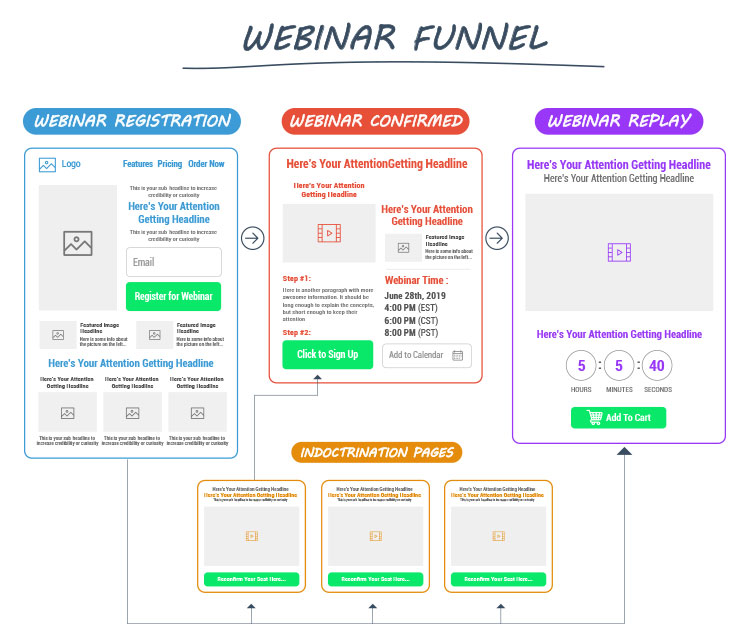



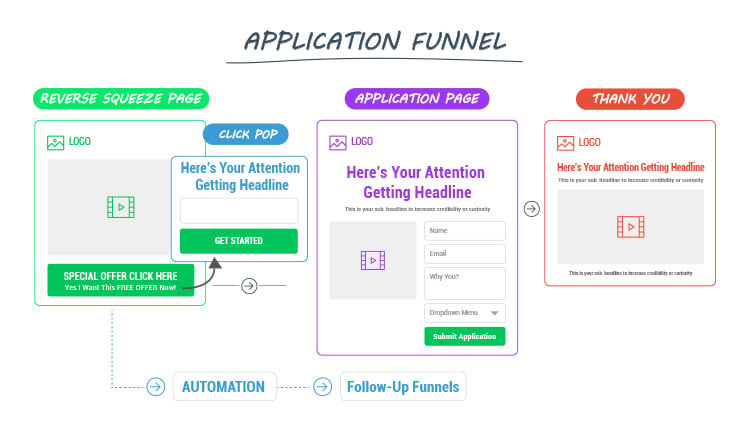
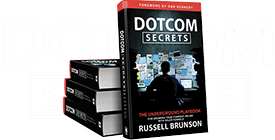
wow.. this information is very easy to understand.. I really liked to read this..
Anita, really glad we were able to move you forward!